SIG
Bergmann submachine gun
Maschinenpistole SIG Bergmann
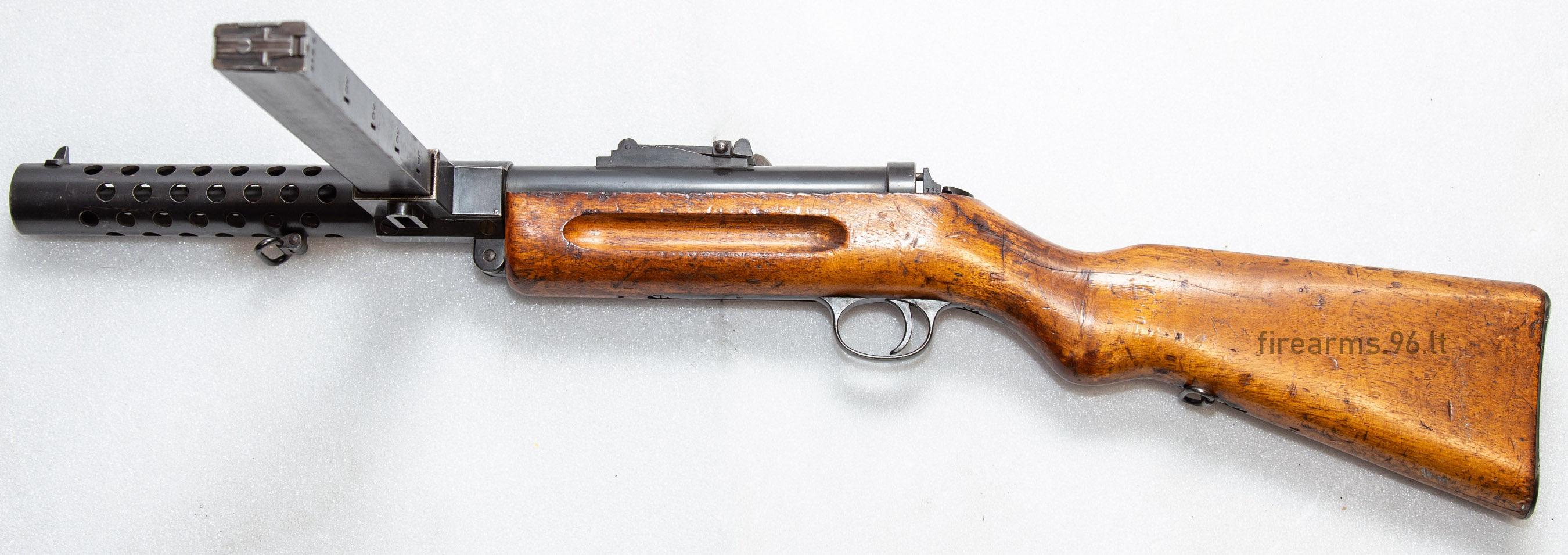 Standard model
SIG Bergmann Model 1920 submachine gun in 7.65mm Parabellum, with
50-round magazine.
Standard model
SIG Bergmann Model 1920 submachine gun in 7.65mm Parabellum, with
50-round magazine.
(Author's photo via Royal
Armouries Collection)
In
1918 the German Army introduced into service the Bergmann M.P.18,I, one
of the very first weapons of the submachine gun class. The M.P.18,I was
designed by Hugo Schmeisser and produced at the Suhl factory of Theodor
Bergmann, a well-known industrialist. Several thousand M.P.18,Is were
produced and issued to German troops over the course of the year, but
when the Great War came to an end in November, the M.P.18,I no longer
had a secure place in military service. It is often said that the weapon
was specifically banned from production following the signing of the
Treaty of Versailles in 1920, however there is no clause in the treaty
that mentions submachine guns or machine-pistols. According to Paul Cornish, Waffenfabrik
Bergmann does not actually appear on the list of factories which were
banned from producing "war materials", and I myself have been unable to find
anything in writing that suggests that Bergmann could not have continued
production of the M.P.18,I after 1920 - in fact, he may well have done,
as the facts surrounding the weapon's manufacture are still not entirely
known.
Regardless of Bergmann's situation in Germany, it is known that in 1920,
Theodor Bergmann granted a production license for the M.P.18,I to Schweizerische Industrie
Gesellschaft (SIG) in Switzerland. Bergmann's
motivation for doing this was probably to open up an export market for
the gun, as the Versailles terms did heavily restrict arms exports
coming out of Germany and therefore some German armaments companies
exploited a loophole in the treaty by outsourcing manufacture of their
products to third-party firms outside of the country's borders. By
manufacturing the M.P.18,I in Switzerland, it was not subject to any
sales restrictions and Bergmann could profit from commercial sales of
the weapon.
The resultant weapon that came out of this arrangement is usually
referred to as the SIG Bergmann Model 1920, although it was marketed
as the "Bergmann Machine Pistol" in its day. Despite being based on
the M.P.18,I, it was not - as is often claimed - a straight copy of
that gun. The SIG Bergmann in fact exhibited several deviations from
the German design which made it unique. The most notable was the
complete change of magazine feed. While the German M.P.18,I employed a
45° canted feed system which took TM08 "Trommelmagazins"
(drum magazines), the SIG Bergmann had a 90° magazine housing which
took straight box magazines. Later model M.P.18,Is also featured a box
magazine feed, although these again differed from that of the SIG
Bergmann. The Schmeisser-designed feed seen on the M.P.18,I was
distinctive in that it had a large diagonal section on top of which
the magazine release button was located. On the SIG Bergmann feed,
this section was absent and the magazine release catch was situated on
the underside of the magazine housing.
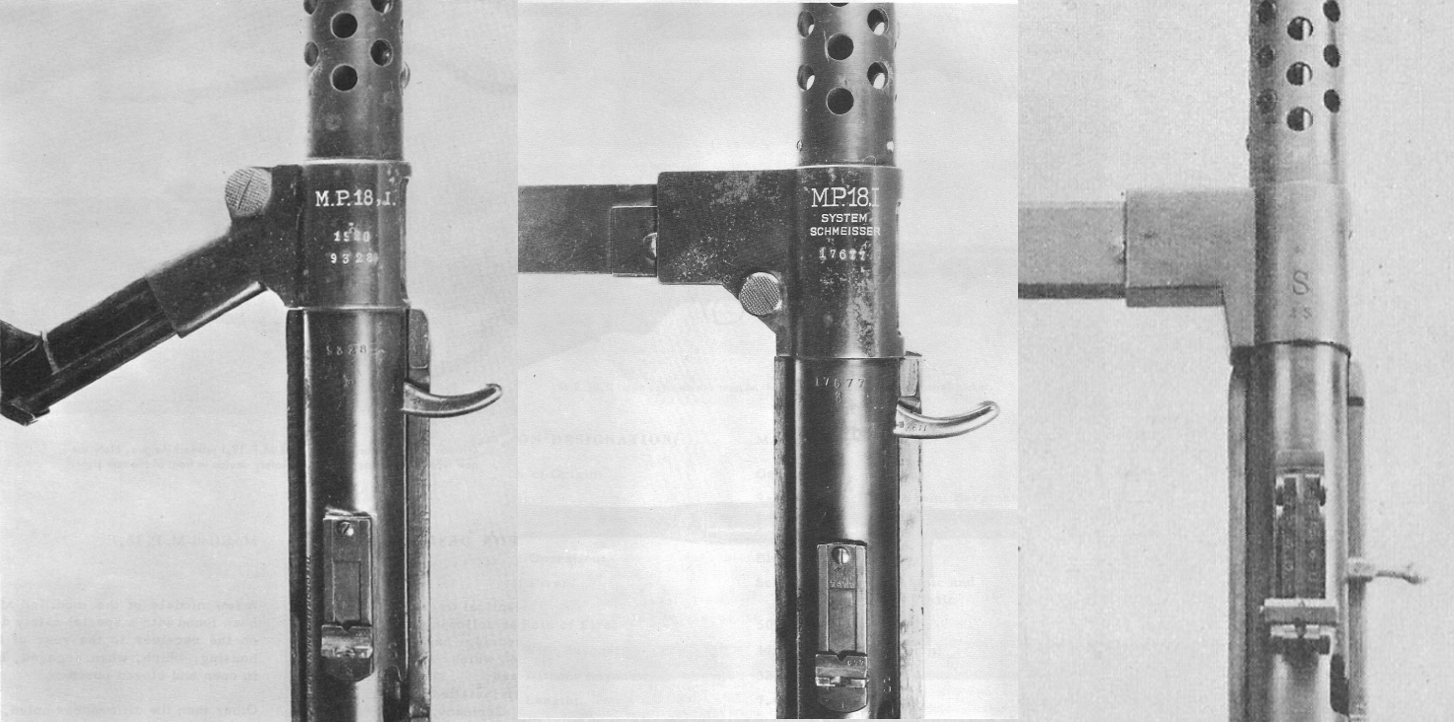
The magazine feeds of the M.P.18,I (left), M.P.18,I modified
(center), and SIG Bergmann (right).
Also note the difference in sights and cocking handles.
(Thomas Nelson)
Along with the new feed system on the SIG Bergmann, the magazines
themselves were also different. As noted, the standard M.P.18,I fed
from canted drum magazines. The later improved M.P.18,I fed from
Schmeisser's patent box magazines of 20 or 32 rounds, which were
double-stacked but single-feed, with a rectangular steel collar at the
feed lips. The interior of the magazine well on the M.P.18,I had
rectangular cut-ins to accommodate for the magazine collar. The SIG
Bergmann magazines were entirely different. They were double-stacked
and double-feed, with a 50-round capacity only. There was no collar at
the lips and therefore the magazine well of the SIG Bergmann was a
straight rectangular shape with no cut-ins. The SIG Bergmann box
magazines and the Schmeisser box magazines were not at all compatible
or interchangeable. Magazines for the SIG Bergmann were, in fact,
stamped with serial numbers corresponding to specific guns, and
according to Thomas Nelson, the magazines were individually
hand-fitted to these corresponding guns.
The magazines were not only different in design, but built to
house entirely different cartridges from Schmeisser's
magazines. The SIG Bergmann was mainly produced in
7.65x21mm Parabellum
(.30 Luger) and 7.63x25mm Mauser (.30 Mauser); only a very small number were made in 9x19mm Parabellum. The M.P.18,I, on the other
hand, was never made in 7.65mm or 7.63mm, and was only made in
9mm. Some Schmeisser magazines were made for 7.65mm and
7.63mm, but only after the introduction of the M.P.28,II in
the late 1920s.
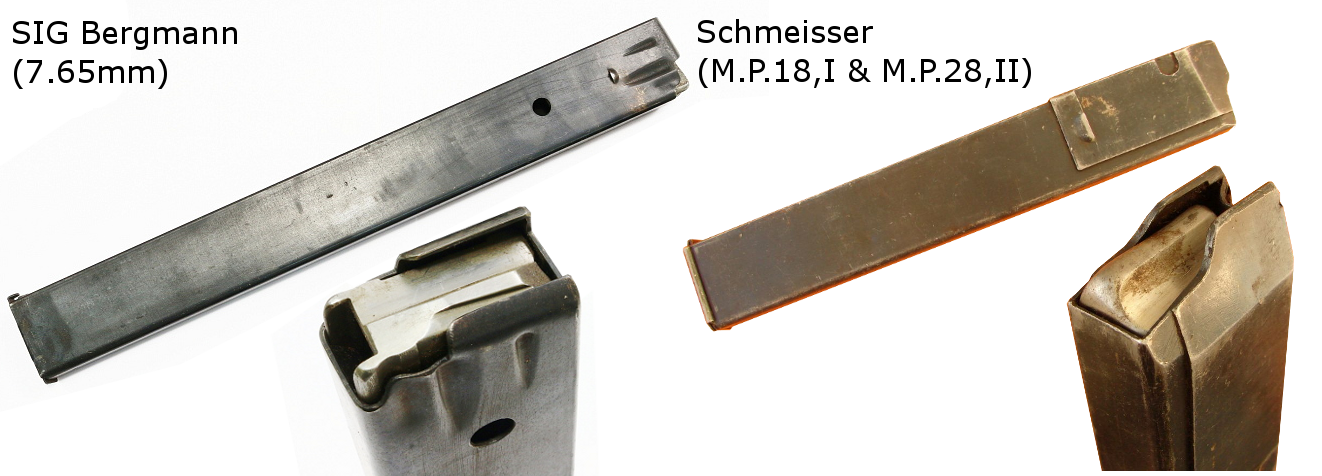
50-round SIG Bergmann magazine for
7.65mm Parabellum (left), compared to 32-round Schmeisser
magazine for 9mm Parabellum (right). Note the clear difference in
feed lips.
(left: Liberty Tree Collectors)
(right: Genuine-Militaria)
Beyond the major deviation in the type of feed system, the other
features that made the SIG Bergmann distinctive from the M.P.18,I were
mostly detail changes. The flip-up rear notch sight of the M.P.18,I
was replaced with an adjustable tangent sight graduating to 1,000
meters. The barrel jacket had only seven perforated holes per row
instead of eight, and there was a larger gap between the muzzle and
the barrel perforations - this was probably to make room for a muzzle
ring that was fitted to some models of the SIG Bergmann. The bolt
design was effectively the same, but differed in some minor ways;
there was an extension in the rear of the bolt, and a straight cocking
handle with a round knob instead of the M.P.18,I's curved hook-type
cocking handle. The interior chamber of the SIG Bergmann was built
with two bolt lugs which were not seen in the M.P.18,I.

The M.P.18,I's bolt (left), compared
to the SIG Bergmann's bolt (right). Note that the SIG Bergmann
bolt is longer at the rear and has a straight cocking handle with a
rounded end.
(left: Hermann Historica)
(right: "Wagner")
There are two additional features that are, for whatever reason, only
seen on certain examples of the SIG Bergmann, but were never
universal. These are a large muzzle ring at the end of the barrel
jacket, and a pressure-sensitive trigger giving automatic fire when fully
depressed and single shots when half-pulled. The muzzle ring appears to
be present on only the Japanese and Thai contract models (as noted later in this
article), and may have been added to accommodate for the Japanese-made
bayonet mount that was developed for the gun. The pressure trigger is
somewhat harder to account for. It was the subject of Swiss patent Nr. 108099, applied for by
SIG, but appears to have only been fitted infrequently, and seemingly
at random. Some Brazilian, Finnish, Chinese, and Japanese contract
guns have this trigger, but most simply have a standard
Bergmann-pattern trigger. There is no consistency in the serial number
sequence of the guns that have these triggers, as it is seen on both
early models and late models.
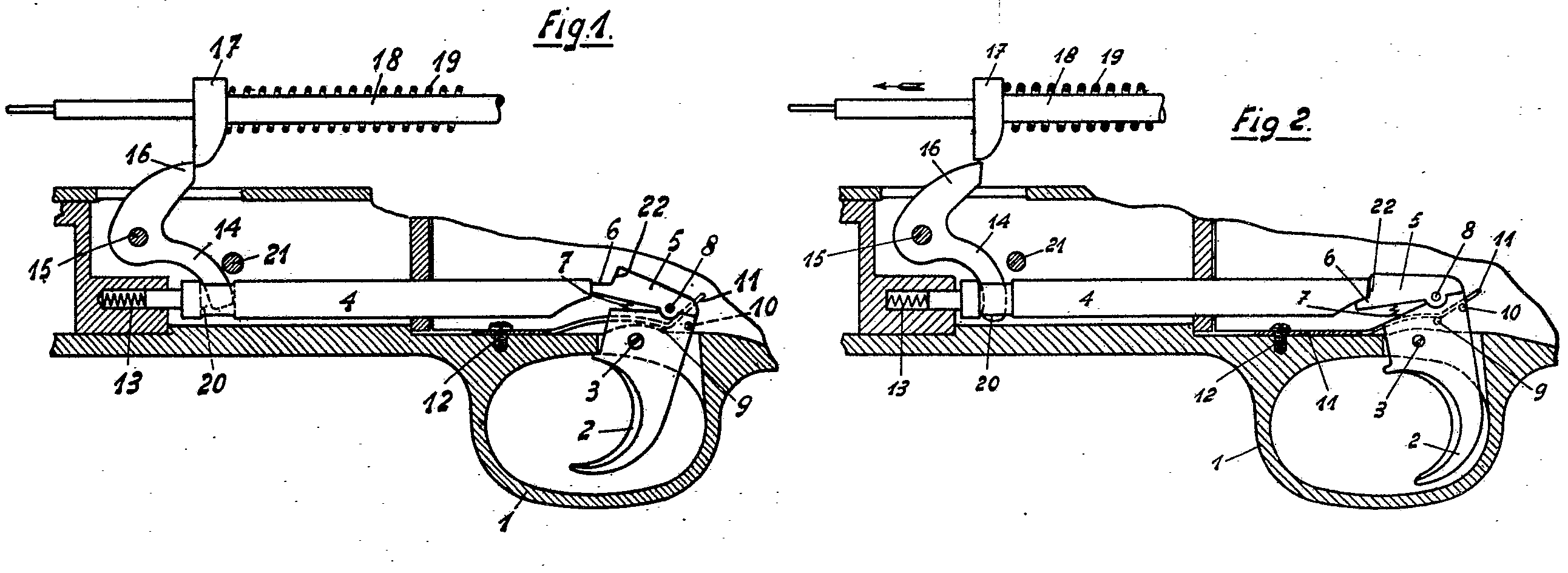 A
proprietary pressure-sensitive trigger developed by SIG for the Bergmann
submachine gun. This seems to
A
proprietary pressure-sensitive trigger developed by SIG for the Bergmann
submachine gun. This seems to
have been fitted to SIG Bergmanns almost at random, appearing on
only some specimens.
The SIG Bergmann entered production and went on sale in 1920. As
noted, it was offered in predominantly in 7.65mm Parabellum and 7.63mm Mauser,
with only a small number being made for 9mm Parabellum. This is because 9mm Parabellum was not yet
widely used outside of Germany and 7mm pistol cartridges were in
greater circulation due to the popularity of the Luger and Mauser
pistols. Domestic interest in the SIG Bergmann was limited. The
Swiss Army bought only 25 units for trials and never adopted it,
but the gun was adopted by the Zürich police. Swiss military
sales were in 7.65mm and police sales were for 9mm guns. Some
police-issue SIG Bergmanns were fitted with wooden foregrips.
However the primary market for the SIG Bergmann was international
export sales, and SIG succeeded in securing major contracts with
several countries in Europe, Asia, and South America.
The
SIG Bergmann in the Baltics
One
of the earliest and most prominent adopters of the SIG Bergmann
submachine gun was the newly-independent Finland, who bought a total of
1,415 of these guns across various orders throughout the 1920s,
beginning in 1922. The Finnish contract SIG Bergmanns were chambered in
7.65mm Parabellum and were stamped "SA" (Finnish property mark) on their
magazines and magwells. Curiously, some of these guns seem to have been
fitted with SIG's pressure trigger, although most were not. Soon
after the weapon's adoption in Finland, there was an attempt to
establish domestic production of the gun at Lindelöf Konetehdas in
Helsinki, but only about 60 guns were
made before this venture was abandoned. By the early 1930s the Finnish
military expressed preference toward the Suomi KP/31 submachine gun,
which largely overshadowed the SIG Bergmann in the ensuing wars against
the Soviet Union. The SIG Bergmann was rendered obsolete in Finnish
service
after World War II and the vast majority of surplus Bergmann SMGs were
sold to the American Interarms company in the 1960s.
Finland was the most consistent
purchaser of SIG Bergmann submachine guns, placing several orders during
the weapons' production run. Finnish contract Bergmanns have been
observed with triple-digit serial numbers (i.e. 212, 498) and four-digit
serial numbers (i.e. 1186, 1418). The highest known serial number for a
Finnish Bergmann is 5151. The Finnish SIG Bergmann was also issued with
a variety of accessories, including a sight re-aligning device that clamped
around the muzzle, and a tool to reshape damaged feed lips for the
magazines.
The SIG Bergmann made it across the
Baltic Sea to Estonia, who also produced a derivative of the gun. The Estonian
Bergmann was produced at Tallinn Arsenal and was based largely
on the SIG gun, although it used entirely different components. It was unusually
chambered in 9x20mm Browning Long - a rare cartridge for submachine guns
- and fed from 40-round box magazines. The stock was of a different
design to the Bergmann and did not have a Pommel grip. The barrel jacket
was also distinctive, as it had rectangular perforations instead of
circular holes. About 570 Tallinn Arsenal submachine guns were produced
from 1927 - 1930, and were issued for a short time to the Estonian Army;
however after their adoption of the Suomi KP/31 in the 1930s they decided to
sell off their Tallinn SMGs, with the majority being illegally
trafficked to Spain during the Spanish Civil War. In Spain they were
used by Republican fighters, but some were captured by the Italian Corpo Truppe Volontarie (CTV) who
took them back to Italy.
 The
rare Tallinn Arsenal submachine gun in 9x20mm, an Estonian derivative of the
SIG Bergmann.
The
rare Tallinn Arsenal submachine gun in 9x20mm, an Estonian derivative of the
SIG Bergmann.The
SIG Bergmann in the South America
In
Brazil, the SIG Bergmann was adopted by police forces in 7.63mm Mauser
and used by them during the so-called "Cangaço"
period, when banditry in rural areas was rife. Special police squads,
led by Lieutenant João Bezerra da Silva and Colonel Manuel Neto, were
organized to pursue the famous bandit Lampião. Colonel Neto
personally carried a SIG Bergmann himself. In the early 1930s the
Brazilian police also made purchases of the M.P.28,II in 7.63mm to
complement their existing supply of SIG Bergmanns, and Bergmann-pattern
SMGs were purchased privately by landowners for issue to their hired
security guards. When Lampião and his gang were tracked down by Bezerra's
forces in 1938, it was reportedly a SIG Bergmann that delivered
the killing blow to the notorious bandit.
The known serial numbers of the Brazilian contract Bergmanns are in the
4,000 range, suggesting they were among the latest adopters of the gun.
During the Chaco War (1932 -
1935), both Paraguay and Bolivia made extensive use of submachine guns.
The Bolivian Army fielded SIG Bergmanns as well as M.P.28,IIs; the
former were probably obtained some years prior to the war. It is not
known in which caliber the Bolivians purchased the SIG Bergmann,
although it may have been 7.63mm Mauser like Brazil. Captured SIG
Bergmanns were apparently pressed into service with the Paraguayan Army.
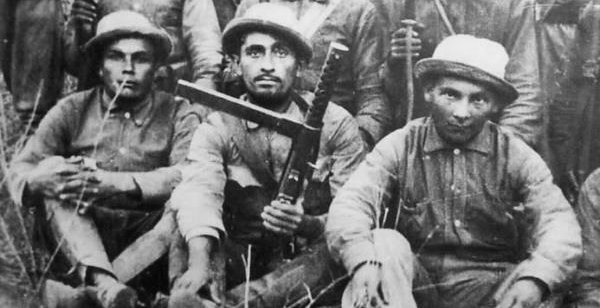 A
Paraguayan soldier wielding a SIG Bergmann, captured from the Bolivian
Army.
A
Paraguayan soldier wielding a SIG Bergmann, captured from the Bolivian
Army.
(Memorias de la Guerra del Chacho)
The
SIG Bergmann in the Far East
The
SIG Bergmann submachine gun found particular success in East Asia, where
it was adopted by at least three countries. The Republic of China made
significant orders for the SIG Bergmann beginning in the early 1920s.
Chinese-contract SIG Bergmanns were produced predominantly in 7.63mm
Mauser - a popular cartridge in China due to the widespread use of
Mauser pistols there - but guns in 7.65mm were also reportedly present.
In addition to the purchase of these guns from Switzerland, the Chinese
produced many copies of the SIG Bergmann at various factories, including
the arsenals at Tsing Tao, Dagu, and Hanyang. Since production of these
guns was decentralized, each factory's version exhibited differences
from one another; for example, the guns produced at Tsing Tao and Dagu
were distinctive in that they used vertical-facing magazine feeds. The Tsing Tao submachine gun, of
which many were made, was used in great quantity by Chinese Republican
troops from the mid-1920s to the 1940s, and proved to be a popular
weapon. SIG Bergmanns were also employed in quantity by Chinese
Communist troops, likely captured from Republican armouries.
Due to a lack of records, it is not known how many SIG Bergmanns were
imported to China from Switzerland, although the weapon was present in
the country before 1925. The number of Chinese-made clones is also
unknown, but was likely in the thousands. Probably more guns were made
in local factories than were actually purchased from SIG.
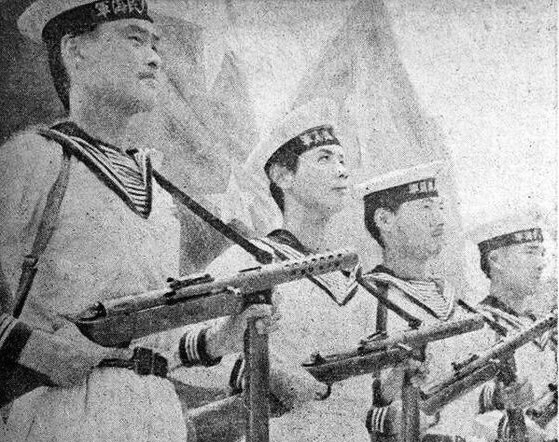

Left: Chinese sailors wielding "Tsing
Tao 16th Year" submachine guns; these were copies of the SIG Bergmann
with
vertical magazine feeds. Right: Chinese Communist troops with SIG
Bergmanns, probably domestic copies.
The Imperial Japanese Navy placed
two separate orders for the SIG Bergmann, the first in 1922 for 125
guns, and the second in 1929 for an additional 320 guns; there may have
been other orders, although they are not recorded. In Japanese Naval
service, the SIG Bergmann was known as the "Type Be" (for "Beruguman").
The Type Be submachine gun was issued with a special bayonet mount that
was wrapped around the barrel jacket, taking a Type 30 sword bayonet.
The bayonet mounts were made not by SIG but domestically at Japanese
arsenals. Several hundred Type Be were in service when Japan annexed
Manchuria in 1932, and were used by Naval Marines in policing duties.
SIG Bergmanns were also issued to collaborationist troops of the
Manchukuo Imperial Army during this period. Captured Chinese-service SIG
Bergmanns in 7.63mm only served to increase the Japanese pool of
magazines and ammunition for the Type Be.
When Japan invaded China in 1937, SIG Bergmanns were used by both sides
in substantial numbers. Contrary to popular belief, the Japanese never
issued any M.P.18,I or M.P.28,II submachine guns from Germany; the
Chinese may have imported some M.P.28,IIs, although the vast majority of
"M.P.28,IIs" seen in contemporary photos from China invariably turn out
to be misidentified SIG Bergmanns. As far as is known, the SIG Bergmann
was not issued to Japanese troops fighting on the Pacific Front. The
later 8mm Type 100 submachine gun, manufactured in Japan and adopted by
the Imperial Army and Navy, was largely based on the SIG Bergmann and
succeeded it in service.

The Japanese contract "Type Be"
(ベルグマン) submachine gun in 7.63mm Mauser. Note the
pronounced muzzle and proprietary bayonet mount around the barrel
jacket.
(Thomas Nelson)
Siam (now Thailand) also placed an
order for SIG Bergmann submachine guns in 7.65mm, probably in the late
1920s. Siamese-contract SIG Bergmanns were unique in that they had Thai
abugida numeral markings (i.e. ๒, ๓, ๔, etc.) whereas all other versions
of the SIG Bergmann were simply marked with Arabic numerals (i.e. 2, 3,
4 etc.). The marking "BREVET BERGMANN" on the magazine well was also
stamped in a different font to the standard SIG Bergmann, and the
overall finish of the metalwork is rougher than all other versions of
the gun. Some of these traits also appear on late examples of Finnish
contract guns (serials c.4900 - 5200) - this may be an indicator that
late-production Thai and Finnish SIG Bergmanns were not actually
assembled at SIG, but subcontracted to a different company after 1927.
In Siam the SIG Bergmann was used by the police and was unusually
employed as an executioner's gun at Bang Kwang Central Prison near
Bangkok. Rather than execution by firing squad, prisoners condemned to
death were tied to a cross-beam, and then shot in the back with an
automatic burst of fire from the executioner's SIG Bergmann. The
Bergmann MP 35/I was also used in this role, and these guns continued to
be used for executions up until the 1980s, when they were both
superseded by the H&K MP5SD. This method of execution is no longer
carried out in Thailand.
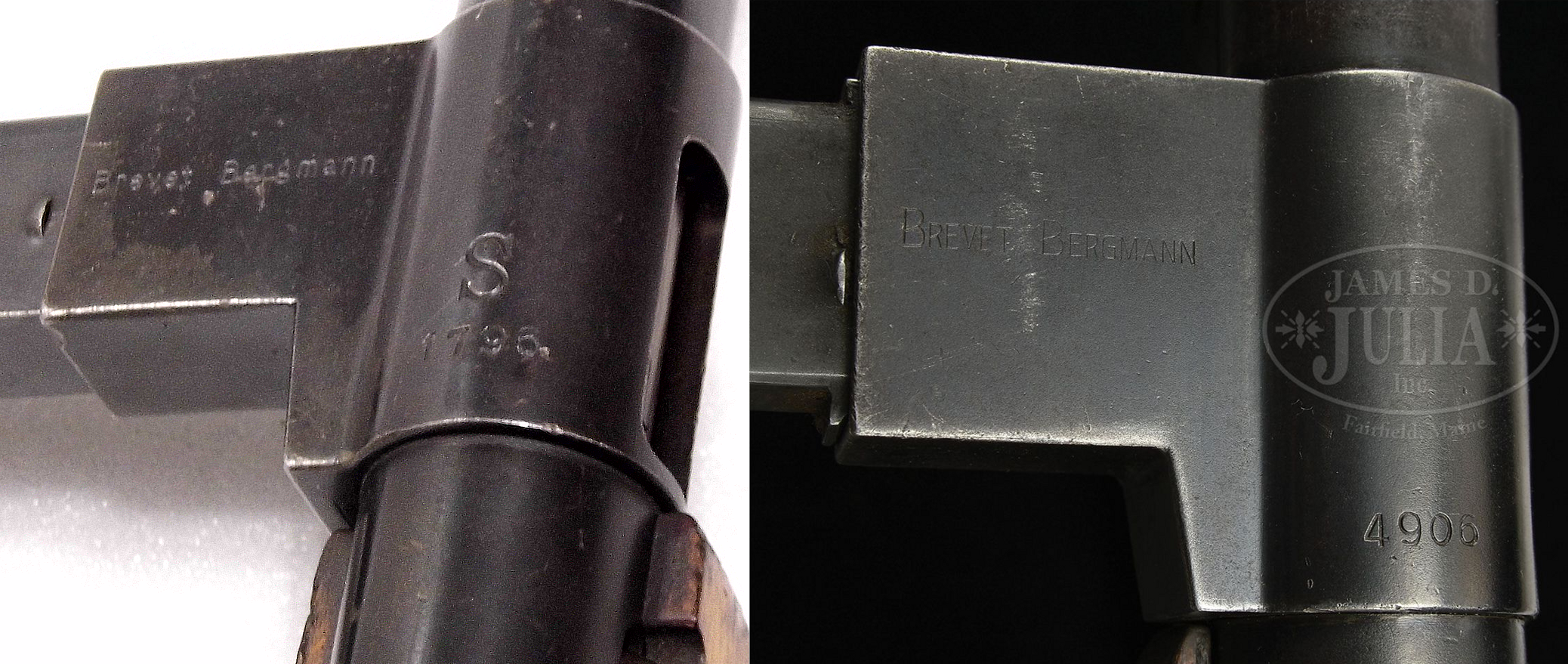

Comparison of the markings on the
standard SIG Bergmann (left) and the Siamese contract model (center);
note the different fonts in "Brevet
Bergmann". On the right is a comparison of the Siamese sight (top) and
the standard tangent sight (bottom). Other than the different
numerals,
it can also be observed that the entire sight design is different. The
reason for these changes is not known.
(left and lower right: Author's photo via Royal Armouries Collection)
(center and upper right: James D. Julia Inc.)
The American Bergmann - the
"Daniels Rapid-Fire Carbine"
The SIG Bergmann even reached the
United States, where it became implicated in one of the most notorious
episodes of the "roaring twenties". A Chicago gun dealer, Vincent
Daniels, imported 7.65mm SIG Bergmann submachine guns which he modified
in-house by fitting two-position fire-selector switches (giving
automatic and single-fire) behind the end cap of the receiver. This fire
selector arrangement was somewhat similar to the later Lanchester
submachine gun developed in Britain. The magazine housings of these guns
were etched with "DANIELS RAPID-FIRE CARBINE" and marketed under that
name. These so-called Daniels carbines were sold, along with Thompson
guns, to gunmen of Al Capone's Chicago Outfit and "Bugs" Moran's North
Side Gang, during the bitter street war between these two rival gangs in
the 1920s, which culminated with the infamous St. Valentin's Day
Massacre in February 1929. Daniels-modified SIG Bergmanns were not used
in the massacre, but they were among the guns that were confiscated in
the ensuing and highly-publicized police round-ups. It is not known how
many Daniels-modified SIG Bergmanns were sold in the US, but likely very
few.

 The
fire selector switch of the "Daniels Rapid-Fire Carbine" (left) along
with the magazine well, with no serial number markings (center).
The
fire selector switch of the "Daniels Rapid-Fire Carbine" (left) along
with the magazine well, with no serial number markings (center).
Right: American lawmakers observe
submachine guns confiscated from Al Capone's triggermen, including a
Daniels carbine.
(left and center: Forgotten Weapons)
The
end of the SIG Bergmann submachine gun
Production of the SIG Bergmann ceased
in 1927, although sales continued until the end of the decade. The known
serial number range suggests that just over 5,000 units were made in
total, although this does not account for the thousands of unlicensed
copies that were also produced in China. In 1928, Hugo Schmeisser
introduced his own updated version of the M.P.18,I which he named the
M.P.28,II. The M.P.28,II was produced at C.G. Haenel in Germany and
Pieper in Belgium. The cessation of the SIG Bergmann from production
just before the M.P.28,II was introduced to the market may not be
coincidental; it seems possible that Schmeisser could have had SIG's
production license revoked to avoid competition between the SIG Bergmann
and the M.P.28,II, although there is currently no documentary evidence
to determine an answer. Nevertheless a new variant of the SIG Bergmann
did briefly appear in 1930. This gun featured a large detachable
foregrip and, unusually, a right-facing magazine feed. The latter
feature was probably intended to increase user comfort when the weapon
was carried over the right shoulder, so as to avoid the long 50-round
magazine jutting into the user's back. The Model 1930 SIG Bergmann was,
however, only made in limited numbers, likely a few hundred at most. It
was reputedly intended for export, although it seems plausible that it
may have been commissioned for the Swiss police. In any case it was
quickly discontinued.
The end of the SIG Bergmann gave way
not only to Schmeisser's M.P.28,II but also another German-designed
submachine gun that was produced in Switzerland, the Steyr-Solothurn
S1-100. Some former customers of the SIG Bergmann decided to purchase
these guns in the 1930s, in place of ordering new shipments of SIG guns.
Meanwhile SIG themselves moved away from the Bergmann submachine gun and
shifted their focus towards their own designs, particularly those
developed by the design trio of Gotthard End, Jakob Gaetzi, and Pál
Király.
Gallery
(Click to enlarge)
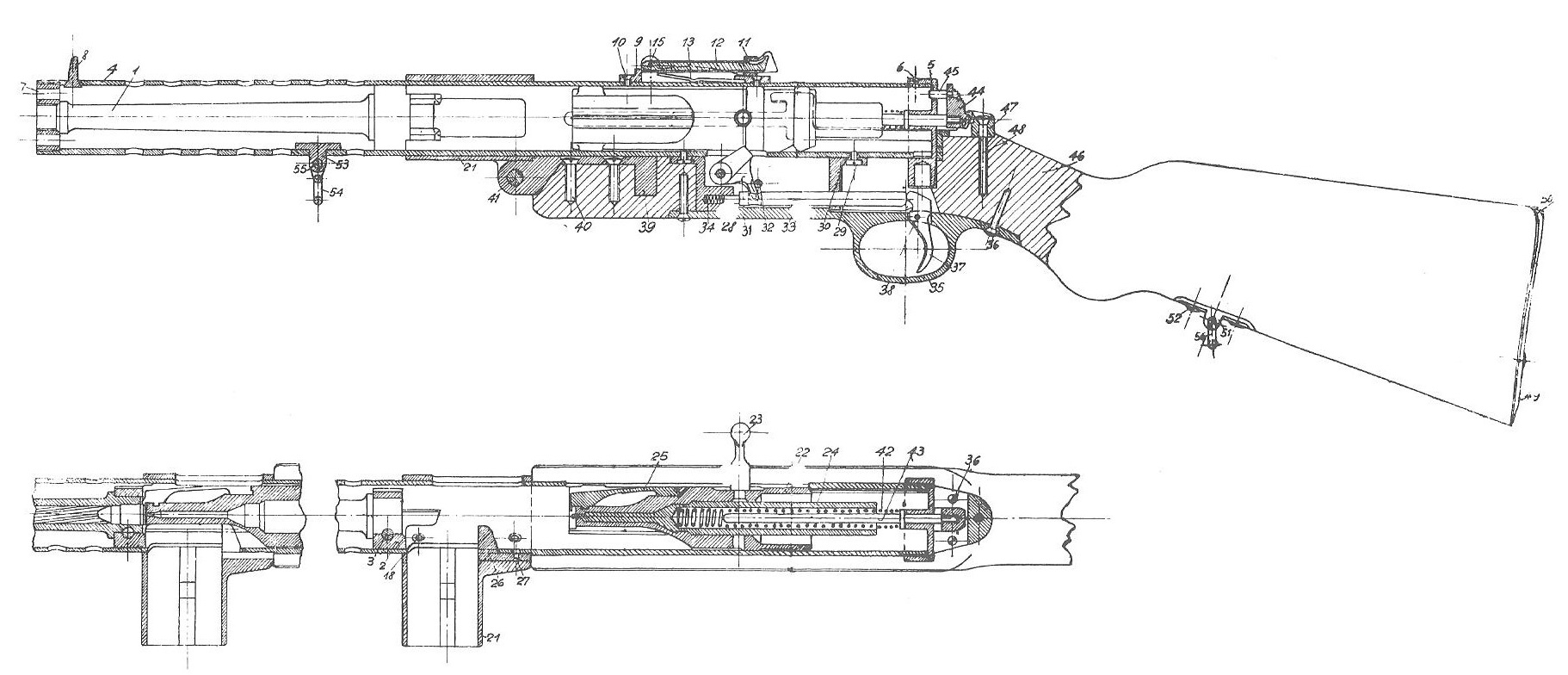
Back
to database














